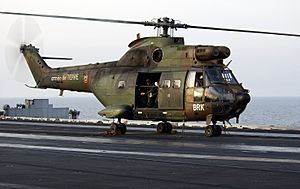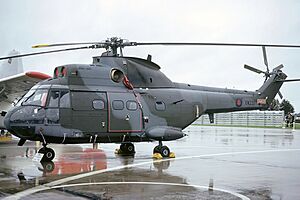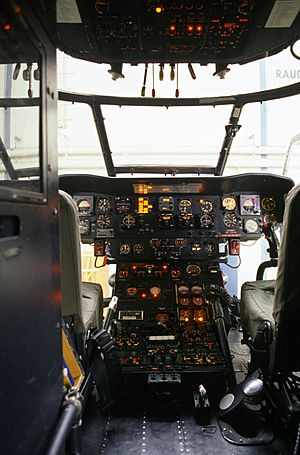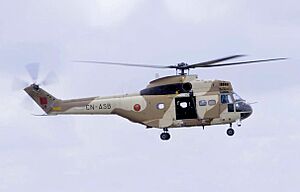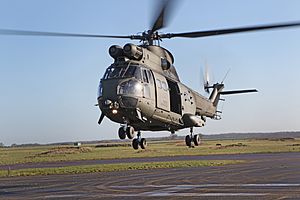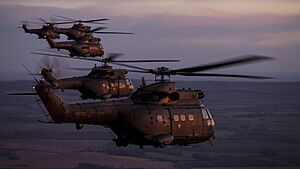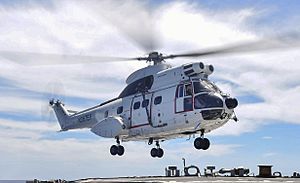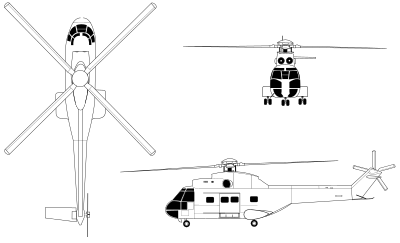Aérospatiale SA 330 Puma facts for kids
Quick facts for kids SA 330 Puma |
|
|---|---|
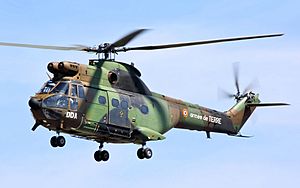
A French Army Puma performing over RIAT, 2010
|
|
| General information | |
| Type | Utility helicopter |
| National origin | France |
| Manufacturer | Sud Aviation Aérospatiale |
| Status | In service |
| Primary users | French Army |
| Number built | 697 |
| History | |
| Manufactured | 1968–1987 |
| Introduction date | 1968 |
| First flight | 15 April 1965 |
| Variants | IAR 330 Atlas Oryx |
| Developed into | Eurocopter AS332 Super Puma Eurocopter AS532 Cougar Denel Rooivalk |
The Aérospatiale SA 330 Puma is a powerful helicopter from France. It has four main rotor blades and two engines. It was built to carry people and supplies.
The Puma was created in the mid-1960s for the French Army. They needed a medium-sized helicopter that could fly in any weather. It uses two Turbomeca Turmo engines. The Puma can carry up to 16 soldiers or six stretchers with four helpers. It can also lift up to 2,500 kg (about 5,500 pounds) of cargo. This cargo can be carried inside or slung underneath.
The Puma's design was very advanced for its time. It had a special system to check its rotor blades. It also had ways to reduce vibrations from the main gearbox and rotor blades. This helicopter was made to fly at night and in tough conditions. It could handle climates from very cold Arctic areas to hot deserts. The Puma also has extra power. This means it can still fly well even if one engine stops working.
The first test flight of the Puma was on April 15, 1965. The first helicopter ready for production flew in September 1968. The French Army started getting them in early 1969. The Puma quickly became very popular around the world. Production of the Puma continued into the 1980s. It was also built in Romania under a special agreement. Other similar helicopters were made in South Africa. Newer versions like the Eurocopter AS332 Super Puma are still being made today.
The Puma has been used in many important events. These include the Gulf War, the Falklands War, and other conflicts. Many countries have updated their Pumas. They added new features like glass cockpits (digital displays) and Global Positioning System (GPS) navigation. They also added defense systems. The Puma was also popular for civilian use. Many companies used it to transport people to oil platforms in the North Sea.
Contents
How the Puma Helicopter Was Developed
The SA 330 Puma was first designed by Sud Aviation. The French Army needed a helicopter that could carry up to 20 soldiers. It also needed to carry different types of cargo in all weather. Work on this new helicopter began in 1963.
The first Puma test helicopter flew on April 15, 1965. Six more test models were built after that. The last of these flew in July 1968. During testing, one Puma had a special tail rotor called a Fenestron. But designers decided a regular tail rotor was better for production models. The first production Puma flew in September 1968. The French Army started receiving them in early 1969.
In 1967, the Royal Air Force (RAF) in the UK chose the Puma. They were impressed by how well it performed. It was called the Puma HC Mk 1 in British service. A big agreement was made between Aerospatiale (French) and Westland Helicopters (British). This teamwork led to the UK buying French Gazelle helicopters. France also bought British Lynx helicopters. Westland built parts and put together Pumas for the RAF.
The SA 330 was very successful around the world. Many countries bought military versions for their armies. It was also popular for civilian use. Companies used it to transport people to offshore oil platforms. For most of the 1970s, the SA 330 Puma was the best-selling transport helicopter in Europe. By July 1978, over 50 Pumas had been delivered to civilian customers. The worldwide fleet had flown over 500,000 hours.
Romania made an agreement with Aerospatiale to build the Puma. They called it the IAR 330. Romania built at least 163 of these helicopters. They were for the Romanian military, civilian users, and other countries. Indonesia also built the SA 330. South Africa was a big user of the Puma. They upgraded their own Pumas. The upgraded helicopter was called the Atlas Oryx. In the 1990s, Denel also developed an attack helicopter for South Africa. It was based on the Puma and called the Denel Rooivalk.
In 1974, Aerospatiale started working on better Puma versions. They wanted to create a new helicopter to replace it. This led to the AS332 Super Puma. The first AS332 Super Puma flew on September 13, 1978. It had stronger engines and a longer body. By 1980, more Super Pumas were being built than the original SA 330 Puma. Aerospatiale stopped making the SA 330 Puma in 1987. By then, 697 had been sold. Romania continued to produce them into the 21st century.
What Makes the Puma Helicopter Special?
The Aérospatiale SA 330 Puma is a helicopter with two engines. It is mainly used to carry people and supplies. For troops, it can hold up to 16 soldiers on foldable seats. For medical help, it can carry six stretchers and four extra people. The Puma can also carry cargo. It can lift up to 2500 kg (about 5,500 pounds) of cargo. This can be done by carrying it inside or using a special hook underneath. Civilian Pumas have different inside layouts for passengers, including important people (VIPs). For search and rescue, a hoist (a lifting device) is often added to the side.
Two Turbomeca Turmo engines on the roof power the Puma's four main rotor blades. These blades spin at about 265 times per minute. The helicopter's transmission system was very new for its time. It had special ways to reduce vibrations. The Puma also had an automatic system to check its blades for cracks. It has two separate hydraulic systems. One controls the flight, and the other handles the autopilot, landing gear, and rotor brake.
The Puma was designed to be fast and easy to control. It also performs well in hot places and at high altitudes. Its engines have a lot of extra power. This allows the Puma to fly effectively even with only one engine working. The cockpit has controls for both a pilot and a co-pilot. There is also a third seat for another crew member. The Puma has an autopilot system that helps keep it stable.
The Puma can be easily transported by large cargo planes. Its main rotor, landing gear, and tail can be removed to make it smaller. It was designed to be easy to maintain. Many parts that need checking are visible from the ground. The Puma can also fly at night and in bad weather. It works well in very cold or very hot environments.
Over time, many Puma operators have added new features. The RAF Pumas have Global Positioning System (GPS) navigation. They also have defense systems like infrared countermeasures and automatic flares to protect against missiles. They use night vision goggles for night flights. The French Army has updated their Pumas with new digital systems. These include mission control systems. Some companies have also updated Pumas with glass cockpits (digital displays).
Puma Helicopter in Action
Argentina
During the Falklands War in 1982, Argentina used five SA 330 Pumas from their army. One Puma from their Coast Guard was also used. All of these helicopters were lost in the conflict. On April 3, a Puma was badly damaged by small arms fire while landing troops. It crashed soon after. On May 9, a Puma was destroyed by a British missile.
On May 23, two British Sea Harriers attacked three Argentine Pumas. One Puma crashed, and another was destroyed by cannon fire. The third Puma escaped. On May 30, a Puma was lost near Mount Kent. It might have been hit by friendly fire. An article said a Puma was shot down by a FIM-92 Stinger missile fired by British Special Air Service (SAS) troops. Six Argentine special forces were killed, and eight were wounded.
France
In September 1979, four Pumas helped transport a French team during Operation Barracuda. They flew directly to the government building in the Central African Empire. They quickly moved important items and records to the French embassy.
French Pumas were also used to transport the President of France. These duties were later taken over by the larger AS332 Super Puma.

During the 1991 Gulf War, France sent several Pumas to support the forces fighting Saddam Hussein's Iraq. Pumas used for combat search-and-rescue were quickly given GPS receivers to help with navigation.
In the 1990s, French Pumas were part of the NATO mission in the Yugoslav Wars. They worked with Pumas from Britain and the United Arab Emirates. A common mission was delivering humanitarian aid to refugees. In April 1994, a French Puma rescued a British SAS team and a downed pilot at night from inside hostile territory. The helicopter came under fire as it left. On June 18, 1999, 20 Pumas carried French paratroopers. This helped NATO forces quickly secure Kosovska Mitrovica.
By 2010, the French Army and Navy decided to replace the Puma with the NHIndustries NH90. Starting in June 2014, two Pumas were sent to Chad and Niger. This was part of Operation Barkhane to fight against rebels. They supported ground troops and stopped supply routes. About 20 SA 330 Pumas were still in the French Air and Space Force in 2016.
Lebanon
Between 1980 and 1984, the Lebanese Air Force received ten SA 330C Pumas from France. They were based at Beirut Air Base. In 1983, the squadron moved north of Beirut for safety. On August 23, 1984, a Puma carrying high-ranking military officers crashed in thick fog near Beirut. All on board were killed. On June 1, 1987, the Lebanese Prime Minister was killed on a Puma. A bomb exploded in a briefcase on his lap. The helicopter was badly damaged.
During the end of the Lebanese Civil War, the Puma fleet was reduced to six or seven helicopters. They were mainly used for flights to Cyprus. But lack of fuel and maintenance problems often kept them on the ground.
After the war, the Lebanese Air Force worked to rebuild its helicopter fleet. With help from the United Arab Emirates, seven IAR 330 SM helicopters were delivered in 2010.
In 2013, the Lebanese Air Force turned an IAR 330 SM into a helicopter gunship. They added a 30mm cannon and 68mm rocket launchers. This modified Puma was called SA 330SM. It was tested on October 10 of that year. The tests were successful, but it was not used in active service. The Lebanese Air Force decided to use an armed version of the Eurocopter AS532 Cougar instead.
Morocco
In 1974, Morocco agreed to buy 40 Puma helicopters from France. In the 1970s and 1980s, Moroccan Pumas fought against separatists. They helped Morocco control the Western Sahara region. However, Moroccan air power was limited after several aircraft were lost to anti-aircraft missiles in the early 1980s.
In October 2007, Morocco and France made a €2 billion deal. As part of this, 25 Moroccan Pumas were to be greatly modernized and upgraded.
Portugal
In 1969, Portugal was one of the first countries to buy the Puma. They ordered 12 helicopters for the Portuguese Air Force. Portugal was also the first country to use Pumas in combat. This was during the Portuguese Colonial War. The Puma was used to help the smaller Alouette III helicopters. It had greater range and could carry more.
In the 1980s, Portugal secretly helped South Africa. South Africa was under a United Nations ban, so France would not give them Puma upgrades. Portugal ordered more powerful engines and new electronics. They said it was for their own Pumas. But many parts were sent to South Africa. There, they were used to upgrade South Africa's Pumas. This resulted in the Atlas Oryx. Portuguese Pumas also received major upgrades as part of this deal.
In 2006, the Portuguese Air Force started getting new AgustaWestland AW101 Merlin helicopters. These larger helicopters replaced the older Puma fleet.
Since 2007, Portugal has been trying to sell eight of its retired Pumas. They were still for sale in 2015.
South Africa
From 1972, Pumas used by the South African Air Force (SAAF) were used in South West Africa and Angola. This was during the South African Border War. Pumas carried troops, quickly deployed forces, acted as radio relays, and rescued injured people. They also inserted Special Forces and took part in large operations. Most of South Africa's Pumas and spare parts were bought before a United Nations ban in 1977. South Africa later upgraded many of its Pumas. This led to the Atlas Oryx. They got help and parts secretly from Portugal during the ban.
In December 1979, South Africa said its military was operating in Rhodesia. Pumas were regularly used to support ground forces. In June 1980, 20 Pumas joined 8,000 troops in an invasion of Angola. In 1982, the government confirmed that 15 soldiers were killed when a South African Puma was shot down. This was one of the worst losses in a single event during the conflict.
In the 1990s, there were secret attempts to buy old SAAF Pumas. This was likely for use in the Congolese Civil War. When the cruise ship MTS Oceanos sank off South Africa in 1991, 13 Pumas helped rescue people. They lifted 225 survivors to safety in bad weather.
United Kingdom

The first two Pumas for the Royal Air Force (RAF) arrived on January 29, 1971. The first squadron (33 Squadron) started operating them on June 14, 1971. The RAF ordered 48 Puma HC Mk 1s for transport. During the Falklands War, a Puma from Argentina was captured. It was sent to Britain and used for training. This helicopter was later rebuilt and put into RAF service. The Puma became a common helicopter for British special forces. It was known for being good at secret missions.
Between the early 1970s and 1990s, RAF Pumas were based at several locations. These included RAF Odiham, RAF Gutersloh, and RAF Belize. A small group was also often based in Northern Ireland. In 1994, 230 Squadron moved to Northern Ireland permanently. In 2009, 230 Squadron and 33 Squadron moved to RAF Benson.
RAF Pumas have also served in Venezuela, Iraq, Yugoslavia, and Zaire. Britain often sent Pumas for disaster relief and humanitarian missions. Examples include the 2000 Mozambique flood and the 1988 Jamaican flash flood. They also helped with peacekeeping in places like Zimbabwe.
During the end of the First Gulf War, Pumas from 230 and 33 Squadrons helped move troops quickly. This prevented Iraqi troops from damaging oil fields. From 2003 to 2009, RAF Pumas were used to move troops in the Iraq War. On April 15, 2007, two RAF Pumas crashed during a special forces mission near Baghdad. In November 2007, a Puma crashed during an operation in Iraq. An investigation found it was mainly pilot error. However, the Ministry of Defence was criticized for not giving RAF Pumas night vision goggles. They also had inadequate maintenance checks. These issues were fixed after the incident.
In 2002, Britain bought six old South African Pumas. This was to keep the type in service longer. A big upgrade program started. The first Puma HC Mk2 entered service in late 2012. The upgrades were finished in early 2014. This allowed RAF Pumas to stay in service until 2025. The plan was to upgrade 30 Pumas, then 22, and finally 24 HC Mk2 Pumas. Upgrades included new engines, gearboxes, and tail rotors. They also got new digital controls, an autopilot, and better defense systems. The HC Mk2 Puma can carry twice the cargo three times farther than the older version. It has been used for troop transport and humanitarian missions.
The RAF stopped using Pumas on March 31, 2025. New helicopters are being bought to replace them.
Private Companies
The American company EP Aviation has used many Pumas in Afghanistan.
Civilian Use
Bristow Helicopters was one of the largest users of the Puma. They regularly used it for offshore operations over the North Sea. In the 1970s, Bristow chose the Puma to replace their older helicopters. From 1979, the Puma became a main part of the Bristow fleet. In 1982, Bristow added the more powerful Super Puma to their fleet of 11 SA 330J Pumas.
The American company Erickson Inc. has used at least four Pumas. They have been used to resupply US Navy ships.
Puma Helicopter Versions


Aérospatiale Versions
- SA 330A: These were the first test models.
- SA 330B: The first version made for the French Army Light Aviation.
- SA 330 Orchidée: A Puma changed to carry a special radar system for the French Army. One was built and flew in 1986.
- SA 330C: The first version made for other countries to buy.
- SA.330E: The version built by Westland Helicopters for the RAF. It was called Puma HC Mk. 1.
- SA.330F: The first civilian version for other countries.
- SA.330G: An improved civilian version.
- SA.330H: An improved version for the French Army and other countries.
- SA.330J: An improved civilian transport version with better rotor blades.
- SA.330L: An improved version for "hot and high" conditions (hot weather and high altitudes).
- SA.330S: An upgraded SA 330L version for the Portuguese Air Force.
- SA.330SM: A Lebanese version changed into a gunship. It had a 30mm cannon and rocket launchers.
- SA.330Z: A test model with a special "fenestron" tail rotor.
- SA.331 Puma Makila: A test helicopter for the AS.332 Super Puma series.
Versions by Other Manufacturers
- Atlas Aircraft Corporation Oryx: A rebuilt and upgraded SA 330 Puma made for the South African Air Force.
- IPTN NAS 330J: A version put together in Indonesia. Eleven were made.
- IAR 330: A version of the SA 330 Puma built in Romania.
- IAR-330 Puma SOCAT: 24 Pumas changed for anti-tank warfare.
- IAR-330 Puma Naval: 3 Pumas changed for the Romanian Navy.
- Westland Puma HC Mk 1: The SA 330E version put together by Westland Helicopters for the RAF.
- Airbus Helicopters Puma HC.Mk 2: Upgraded Puma HC Mk1s. 24 were upgraded with more powerful engines, a glass cockpit, and better defense equipment.
Who Uses the Puma Helicopter?
Current Users
 Brazil Brazilian Air Force
Brazil Brazilian Air Force Chile Chilean Army
Chile Chilean Army Democratic Republic of the Congo Democratic Congo Air Force
Democratic Republic of the Congo Democratic Congo Air Force Ecuador Ecuadorian Army
Ecuador Ecuadorian Army France French Air and Space Force
France French Air and Space Force
- Cayenne – Félix Eboué Airport, French Guiana
- ET 00.068
- Djibouti–Ambouli International Airport, Djibouti
- ET 00.088
- La Tontouta International Airport, New Caledonia
- ET 00.052
- Solenzara Air Base, Haute-Corse, France
- EH 01.044
- Cayenne – Félix Eboué Airport, French Guiana
- French Army Light Aviation
 Gabon Military of Gabon
Gabon Military of Gabon
- Léon-Mba International Airport, Libreville
- Escadrille Aérienne Transport
- Léon-Mba International Airport, Libreville
 Guinea Guinea Air Force
Guinea Guinea Air Force Kenya Kenya Air Force
Kenya Kenya Air Force
- Moi Air Base, Nairobi City County
- Helicopter Squadron
- Moi Air Base, Nairobi City County
 Kuwait Kuwait Air Force
Kuwait Kuwait Air Force Lebanon Lebanese Air Force
Lebanon Lebanese Air Force
- Wujah Al Hajar Air Base, Hamat
- 9 Squadron
- Wujah Al Hajar Air Base, Hamat
 Malawi Malawi Army
Malawi Malawi Army Morocco Royal Moroccan Air Force
Morocco Royal Moroccan Air Force
- First Air Base, Rabat-Salé-Kénitra
- Escadrons de Manoeuvres Tactiques
- First Air Base, Rabat-Salé-Kénitra
 Pakistan Pakistan Air Force
Pakistan Pakistan Air Force- Pakistan Army Aviation Corps
- Multan International Airport, Punjab
- 24th Army Aviation Squadron
- Qasim Airbase, Dhamial
- 13th Army Aviation Squadron
- 28th Army Aviation Squadron
- Multan International Airport, Punjab
 Romania Romanian Air Force (See IAR 330)
Romania Romanian Air Force (See IAR 330)
- 71st Air Base, Cluj County
- Escadrila 712
- Escadrila 713
- 90th Airlift Base, Ilfov County
- Escadrila 903
- 95th Air Base, Bacău County
- Escadrila 952
- 71st Air Base, Cluj County
- Romanian Navy (See IAR 330)
- Tuzla Aerodrome, Constanța County
- Grupul 256
- Tuzla Aerodrome, Constanța County
 Ukraine Ukrainian Air Force
Ukraine Ukrainian Air Force
Past Users
 Algeria Algerian Air Force
Algeria Algerian Air Force Argentina Argentine Army
Argentina Argentine Army- Argentine Coast Guard
 Belgium Gendarmerie
Belgium Gendarmerie Cameroon Cameroon Air Force
Cameroon Cameroon Air Force Ethiopia Ethiopian Air Force
Ethiopia Ethiopian Air Force Indonesia Indonesian Air Force
Indonesia Indonesian Air Force
- Atang Senjaya Air Force Base, West Java
- Wing Udara 4 – Skadron Udara 8 (Retired on December 30, 2023)
- Atang Senjaya Air Force Base, West Java
 Iraq Iraqi Air Force
Iraq Iraqi Air Force Ireland Irish Air Corps
Ireland Irish Air Corps Mexico Mexican Air Force
Mexico Mexican Air Force Nigeria Nigerian Air Force
Nigeria Nigerian Air Force Oman Royal Air Force of Oman
Oman Royal Air Force of Oman
 Philippines Philippine Air Force - 2 Units were bought in 1979 for the Philippine Air Force VIP 700th Special Mission Wing
Philippines Philippine Air Force - 2 Units were bought in 1979 for the Philippine Air Force VIP 700th Special Mission Wing
 Portugal Portuguese Air Force
Portugal Portuguese Air Force Senegal Senegalese Air Force
Senegal Senegalese Air Force South Africa South African Air Force
South Africa South African Air Force Spain Spanish Air and Space Force
Spain Spanish Air and Space Force
- 402 Escuadrón in Ala 48
 Togo Togolese Air Force
Togo Togolese Air Force Tunisia Tunisian Air Force
Tunisia Tunisian Air Force United Arab Emirates United Arab Emirates Air Force
United Arab Emirates United Arab Emirates Air Force United Kingdom Royal Air Force
United Kingdom Royal Air Force
- RAF Odiham, Hampshire, England
- No. 27(R) Squadron (OCU) (1993–1998)
- No. 240 Operational Conversion Unit (1971–1993)
- RAF Aldergrove, County Antrim, Northern Ireland
- No. 72 Squadron (1997–2002)
- RAF Akrotiri, Cyprus
- No. 84 Squadron (2023–2025)
- RAF Benson, Oxfordshire, England
- No. 22 Squadron (OEU) (2020–2025)
- No. 33 Squadron (1971–2025)
- No. 230 Squadron (2023–2025)
- No. 28 Squadron (OCU) (2015–2025)
- Medicina Lines, Brunei
- No. 1563 Flight (1971–1993; 2004–2009; 2022–2023)
- No. 230 Squadron (2023–2025)
- RAF Odiham, Hampshire, England
Notable Accidents
- On March 29, 2022, eight UN peacekeepers were killed. This happened when a Puma helicopter crashed in the Democratic Republic of the Congo. The helicopter was operated by the Pakistan Army Aviation Corps. The cause of the crash is still being investigated.
Puma Helicopter Specifications (SA 330H)
Data from Jane's All The World's Aircraft 1976–77
General characteristics
- Crew: 3
- Capacity: 16 passengers
- Length: 18.15 m (59 ft 6½ in)
- Rotor diameter: 15.00 m (49 ft 2½ in)
- Height: 5.14 m (16 ft 10½ in)
- Disc area: 177.0 m² (1,905 ft²)
- Empty weight: 3,536 kg (7,795 lb)
- Max takeoff weight: 7,000 kg (15,430 lb)
- Powerplant: 2× Turbomeca Turmo IVC turboshafts, 1,175 kW (1,575 hp) each
Performance
- Never exceed speed: 273 km/h (147 knots, 169 mph)
- Maximum speed: 257 km/h (138 knots, 159 mph)
- Cruise speed: 248 km/h (134 knots, 154 mph) econ cruise
- Range: 580 km (313 nm, 360 mi)
- Service ceiling: 4,800 m (15,750 ft)
- Rate of climb: 7.1 m/s (1,400 ft/min)
Armament
- Guns:
- Coaxial 7.62 mm (0.30 in) machine guns
- Side-firing 20 mm (0.787 in) cannon
- Various others
See also
 In Spanish: Aérospatiale SA 330 Puma para niños
In Spanish: Aérospatiale SA 330 Puma para niños
- Aircraft related to this one
- Atlas Oryx
- Denel Rooivalk
- Eurocopter AS332 Super Puma
- Eurocopter AS532 Cougar
- Eurocopter EC225 Super Puma Mk II+
- Eurocopter EC725 Super Cougar
- IAR 330
- Similar aircraft
- Mil Mi-8
- NH 90
- Lists related to this aircraft
- List of rotorcraft


